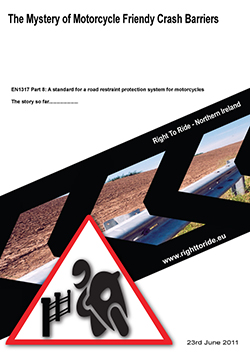 United Kingdom – On Thursday, June 16, the CEN (European Committee for Standardization) technical committee on road equipment (TC226) held its annual meeting in Stockholm. The draft standard for a road restraint protection system for motorcycles (EN1317-8) was on the agenda.
United Kingdom – On Thursday, June 16, the CEN (European Committee for Standardization) technical committee on road equipment (TC226) held its annual meeting in Stockholm. The draft standard for a road restraint protection system for motorcycles (EN1317-8) was on the agenda.
At the meeting, the committee chose to opt for a Technical Specification, which seems to have caused consternation amongst some motorcyclists.
In fact the General Secretary of FEMA (Federation of European Motorcyclists Associations) commented “What will be done with this Technical Specification is a mystery to me. I have my doubts about the legitimacy of the arguments put forward by those who voted ‘no’ to a European Standard”.
Right To Ride contacted the CEN Committee secretary to find out the facts.
 Over the previous months, representatives from various countries raised legitimate concerns about the Spanish protocol, because they felt that there were problems with the testing procedures for motorcyclists hitting crash barriers, the relevance of rider positions when crashing, the types of barriers and so forth. However the committee recognised that in the absence of something better, it was a starting point.
Over the previous months, representatives from various countries raised legitimate concerns about the Spanish protocol, because they felt that there were problems with the testing procedures for motorcyclists hitting crash barriers, the relevance of rider positions when crashing, the types of barriers and so forth. However the committee recognised that in the absence of something better, it was a starting point.
There was the general consensus within the Working Group 1 to develop the Spanish protocol and focus initially on the sliding configuration because the experience already gained with similar testing on a national basis would allow a European standard to be developed more quickly.
At the meeting on June 16th, rather than reject the proposed draft, the committee decided to accept it as a Technical Specification as an interim solution. Thus the committee did not vote “no” to a European Standard.
The convenor of CEN/TC 226/WG1 explained that the plan is to undertake inter-laboratory testing, to ensure that the test procedures are understandable and that when identical tests according to the protocol are performed by different laboratories in different countries, the results obtained are the same.
According to the CEN secretary, the TC226 committee expects to have this standard ready and approved within the next two/three years.
For a better understanding of the issues surrounding motorcycle friendly crash barriers, the involvement of riders’ organisations and the CEN TC226 Committee, read our paper:
“The Mystery of Motorcycle Friendly Crash Barriers” pdf 696kb – Click Here
Federation of European Motorcyclists Associations – CEN misses historic opportunity to adopt European guardrail standard for motorcyclists – Click Here
Original Source: www.righttoride.eu


I’m torn on this issue. I try to be a good ambassador, at least in the rgared of wearing All The Gear, All The Time and whenever I’m walking around in my gear (helmet off), I do my best to be friendly and helpful and portray a positive image.On the road, however, it’s often a different story. I ride safely at all times. But many onlookers and motorists, particularly those who don’t ride, may not agree. Unfortunately, many motorists simply assume that motorcycles are dangerous, and if they happen to be doing anything that gets them noticed, it’s unsafe.I’ve learned over the past couple of years that I am safer if I am travelling FASTER than the flow of traffic. If I stay with traffic, it doesn’t take long for somebody not paying attention (e.g. texting) to unintentionally try to run me off the road. No amount of high-viz gear and lights is going to completely fix this. People just don’t notice us.Then there are the people who simply don’t like bikes to begin with. I NEVER ride directly behind a car. I ride towards the inside of the lane, near the line, so I can split between traffic if I need to e.g. sudden stop, etc. Legal or not, I’m going to do it to avoid an accident. But this tends to piss people off. I dunno if it’s my lights in their mirror, or if they think I’m following too closely. But these people will sometimes brake-check me, or start swerving around, or who knows what. All it takes is for somebody to do stuff like that, and I twist the throttle and I’ll go past them, splitting traffic if necessary. I refuse to behind somebody driving like that. So there’s another strike against us being allegedly unsafe even though we didn’t start it.Motorists seems to think that when motorcycles accelerate, we’re hot-rodding. Point is, bikes accelerate faster than cars, even when we’re taking our time. So again, unsafe. Sigh.I think that most of the issues people have with motorcycles is due to ignorance and bad press. Of course, there are always the few that will ruin it for everybody else usually kids on sport bikes riding recklessly, or the obnoxiously loud Harley that has to be sure he’s heard for miles around.What we need is a heavy PR campaign to educate people about motorcycles. It would also help a LOT to legalize lane splitting everywhere. Not only would it reduce traffic congestion, it would actually make motorcycles more visible, because people would start using their side mirrors and noticing us coming up between them. The studies done about lane splitting have all indicated that it’s safer than not (another major misconception). I learned to ride in Los Angeles and have had 1/10th as many issues with motorists there as I do when I’ve ridden in Nevada and Oregon.There will always be bad apples; hopefully more people will focus on portraying the sport positively and help combat the negative image we’re stuck with.
Translation of the above:
this is only a story of dough
I ride often in Spain, and the fact remains that their barriers inspire more confidence that our “guillotines”
the engineer who laid the report, was it part of our large “family”?
I doubt
Call Lighthouse
Mato
What everybody and evidently you too Mato has not understood is that wire rope barriers or “guillotines” are already within the CEN 1317 standard! The motorcycle “friendly” crash barrier or CEN 1317-8 is simply an addition to the standard barrier. It is not another barrier. Thus if governments wish to use the TC 1317-8, then they can fit protective underguard systems (which is what the motorcycle “friendly” crash barrier effectively is) to the existing barrier which may or may not be a “guillotine”…….I don’t know who Lighthouse is – or maybe something got lost in translation.
It is unfortunate that there is a lot of ignorance regarding the whole issue of crash barriers and what are the current standards. A simple email to the secretary of the CEN Committee might help clarify any misunderstanding.
ce n’est encore qu’une histoire de pognon
je roule souvent en Espagne,et,toujours est-il,que leurs barrières inspirent plus confiances que nos”guillotines”
l’ingénieur qui a pondu ce rapport,faisait-il parti de notre grande ” famille ” ??
j’ai un doute
appel de phare
Mato